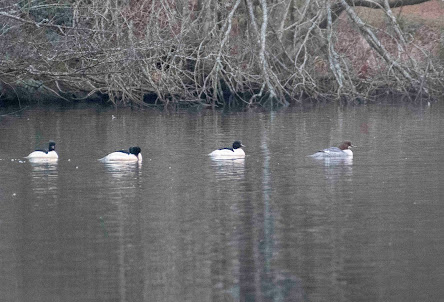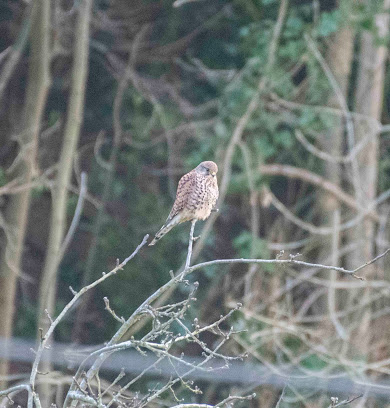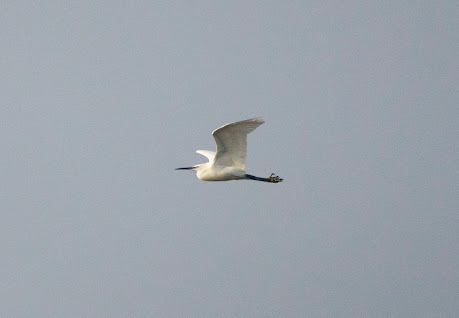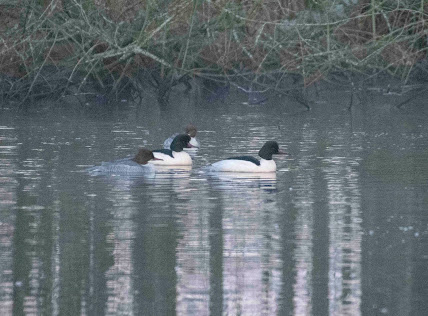January has flown by. The month has been unusually dry, with plenty of bright, crisp winter days to boot, meaning time in the field has often been rather pleasant. Getting to know the new sites close to home and a few early signs of spring have added to the enjoyable flavour 2022 has so far conjured up.
 |
| Fieldfare and frost. |
Monday 17th
The January fall moon shone spectacularly over Hambledon at first light, where a light frost was on the ground. A walk around the arable farmland east of the village produced a few good bits, including three Yellowhammers at Court Farm (perhaps the most reliable site for this species locally), two Reed Buntings, flyover Bramblings and Lesser Redpolls (two of each) and Bullfinch. Good numbers of Redwings were nervously moving from field to field, perhaps on edge due to the presence of a female Sparrowhawk.
 |
| January full moon. |
From there I climbed up Hydon's Ball, where a Lesser Redpoll looked set to highlight until, close to the car park, I bumped into two Marsh Tits. I've never recorded this species here before and it's pleasing to unearth them at new sites, especially away from the Low Weald stronghold. The birds, perhaps a pair, included a singing male. I'm aware of only four other sites within a 4 km radius of Godalming that still supports this declining species.
As I was back in Farncombe today I decided to walk to the Lammas Lands at dusk. It was a beautiful evening and a Little Egret high south-west – presumably to roost somewhere – was good value. I got the thermal imager out when it got properly dark. A few Snipe were flying around but a mega reward came at 17:35 (70 minutes after sunset) when a Barn Owl ghosted through north-east, calling to boot. This is a truly enigmatic species locally and very hard to pin down – my last at the Lammas Lands was in April 2019.
Tuesday 18th
I popped to Eashing Fields mid-morning, where a heavy frost was still coating the ground. Good numbers of birds in the top field included 45 Fieldfares and at least 10 Skylarks – the latter a very pleasing count. The Stonechat pair were still about, but perhaps unsurprisingly there was no sign of the Dartford Warbler from last week. The session was capped off by a surprise Little Egret heading south.
 |
| Little Egret and Stonechat. |
Wednesday 19th
It was much milder as I walked along the river from Eashing this morning, which doubtless contributed to a decent 41 species being logged. Highlights included at least two Marsh Tits (one of which was a singing male), three Mandarin, a (the?) Woodcock flushed from the same ditch as on 12th, two flyover Ravens, some noisy Jays and a singing Red-legged Partridge.
Near the end of the walk, I heard a weird vocalisation – almost like a Marsh Tit mixed call / song. I wasn't overly surprised to find that the perpetrator was a Great Tit. It was a pretty good impression – just a touch more forceful and less drawn out than a Marsh Tit song, and too rapid-fire and loud for a quick series of calls. Some research led me to a paper (Aymi & Riera, 2019) that revealed that, from a sample of Great Tit mimicry cases, Marsh Tit was the second commonest species impersonated.
Thursday 20th
It was cold again this morning. The alfalfa at Shackleford held decent numbers of birds, including 30 or more Skylarks, some 100 winter thrushes and at least 50 Meadow Pipits, the latter count proving my highest local mipit tally of the winter. Four Stonechats were also present. Walking through Peper Harow on the way home produced Ring-necked Parakeet and an unexpected group of 30 Skylarks.
Friday 21st
The temperature dropped as low as -5°C overnight and it was no surprise that Frensham Great Pond was half frozen first thing. More unexpected was a roosting flock of some 82 Canada Geese – perhaps frozen out of a more usual haunt – with a lone Barnacle Goose among them. This is my first local encounter of a feral 'barnie' since September 2020. Five Shoveler and four Pochard were noted among lower than usual numbers of wildfowl, but it was otherwise quiet.
Saturday 22nd
It was a grey and cold winter's morning at Puttenham Common, the journey to which included a Red-legged Partridge running over Suffield Lane. Aside from dogwalkers the common was rather quiet, despite 41 species being noted. Highlights included a flyover Lesser Redpoll and a hooting Tawny Owl, with Cutt Mill holding a Shoveler pair on the house pond, a Kingfisher at The Tarn and 15 Goosander – my highest local count of the winter – across both. A drake of the latter species displayed briefly too.
 |
| Goosander. |
I walked home via Shackleford, where I inadvertently racked up 45 species, meaning my morning stroll ended on a nice round 60 in total. The best bits here included a calling Little Owl and a female Brambling that showed well – albeit briefly – in a flock of Chaffinches. Singles of Raven and Kestrel, 10 Teal and two Ring-necked Parakeets were also noted.
Sunday 23rd
Enton Lakes was quiet first thing, with Kingfisher and Lesser Redpoll highlighting. I then walked the woodland south of Hambledon, where an excellent number of Marsh Tits were located – at least seven around Hambledon Hurst but possibly double-figures. There wasn't much else to report, save a handful of Lesser Redpolls. Some 220 Common Gulls at Milford were of note on the way home, representing my biggest local flock since 2017.
Monday 24th
A Shalford Snipe-stomp failed to deliver, with only six birds seen and no hint of any Jacks. However, four Wigeon on St Catherine's Pool were very notable – my first for the site, which scores this local scarcity once or twice a year. Five Shoveler and two Water Rails were also about.
 |
| Wigeon. |
Tuesday 25th
 |
| Redwing. |
 |
| Marsh Tit. |
 |
| Kestrel. |
 |
| Goshawk action. |
 |
| Peregrine. |










No comments:
Post a Comment